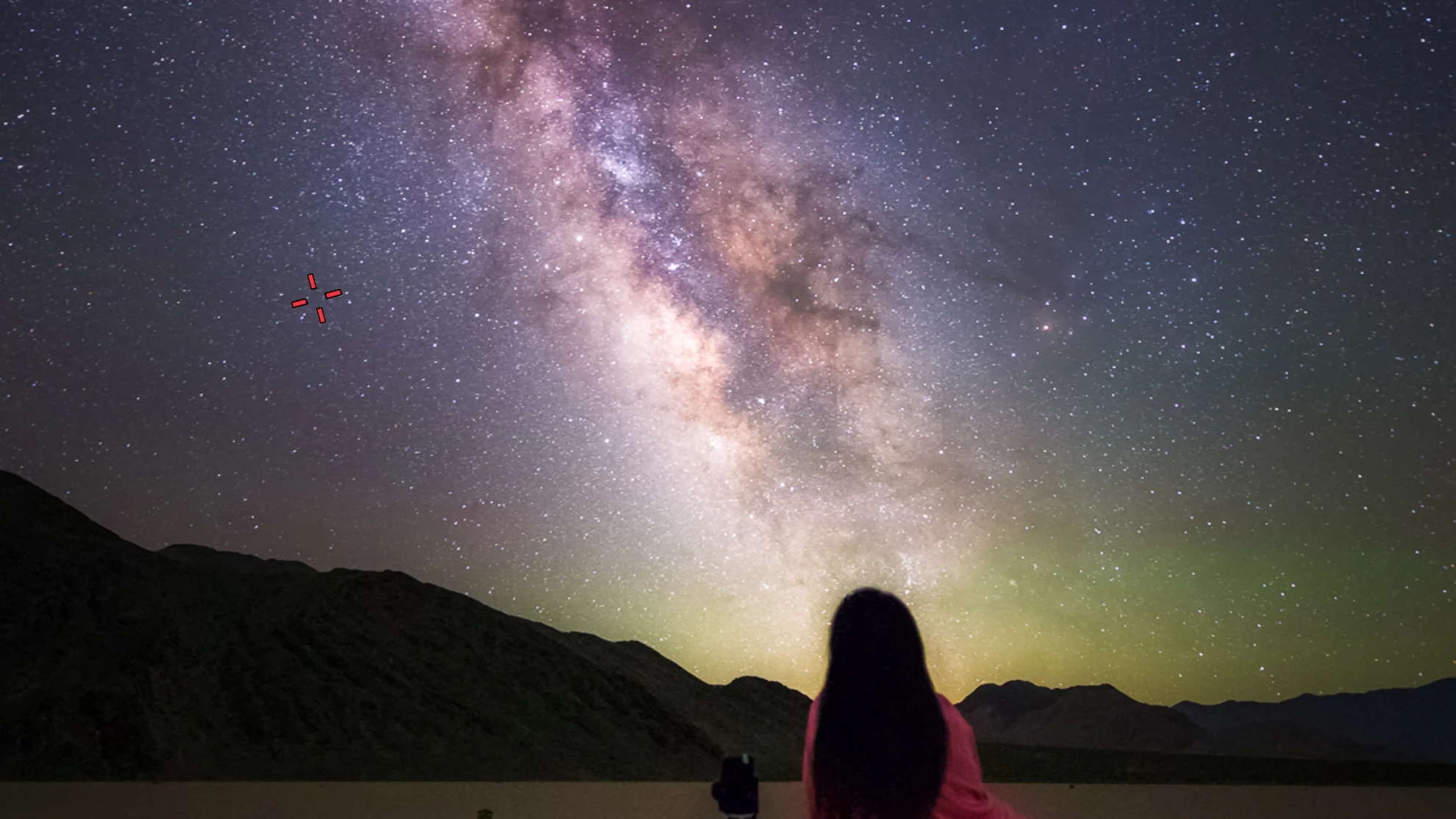
Weather Network meteorologist's name is now written among the stars
One meteorologist's passion for astrophotography has earned her a place in the cosmos.
What's it like to have your name written among the stars? We asked our very own senior meteorologist, Kerry-Ann Lecky Hepburn, after she had a piece of our solar system named after her.
On February 3, 2025, astronomers around the world opened a new bulletin from the International Astronomical Union's Working Group Small Bodies Nomenclature (WGSBN) — the international team of scientists who decide on the naming of comets and asteroids in our solar system.
Among the 43 asteroids detailed in the bulletin that received their new moniker, some were named for space scientists, such as Suzanne Dodd, the Director of the Interplanetary Network Directorate at the Jet Propulsion Laboratory, and Mioara Mandea, the head of the Science Coordination department at France's National Center for Space Studies (CNES). Others were given names from locations, such as Gevrey-Chambertin, a town in France, or mythology, like Taowu, one of China's "Four Perils". Even Adam Nimoy, a television director and filmmaking instructor, now has a place in space alongside his late father, Star Trek legend Leonard Nimoy.
For a certain section of the astronomical community, especially the members of the Royal Astronomical Society of Canada (RASC) and among those of us who work at The Weather Network, one name stood out among the others: (53258) Kerryannlecky.
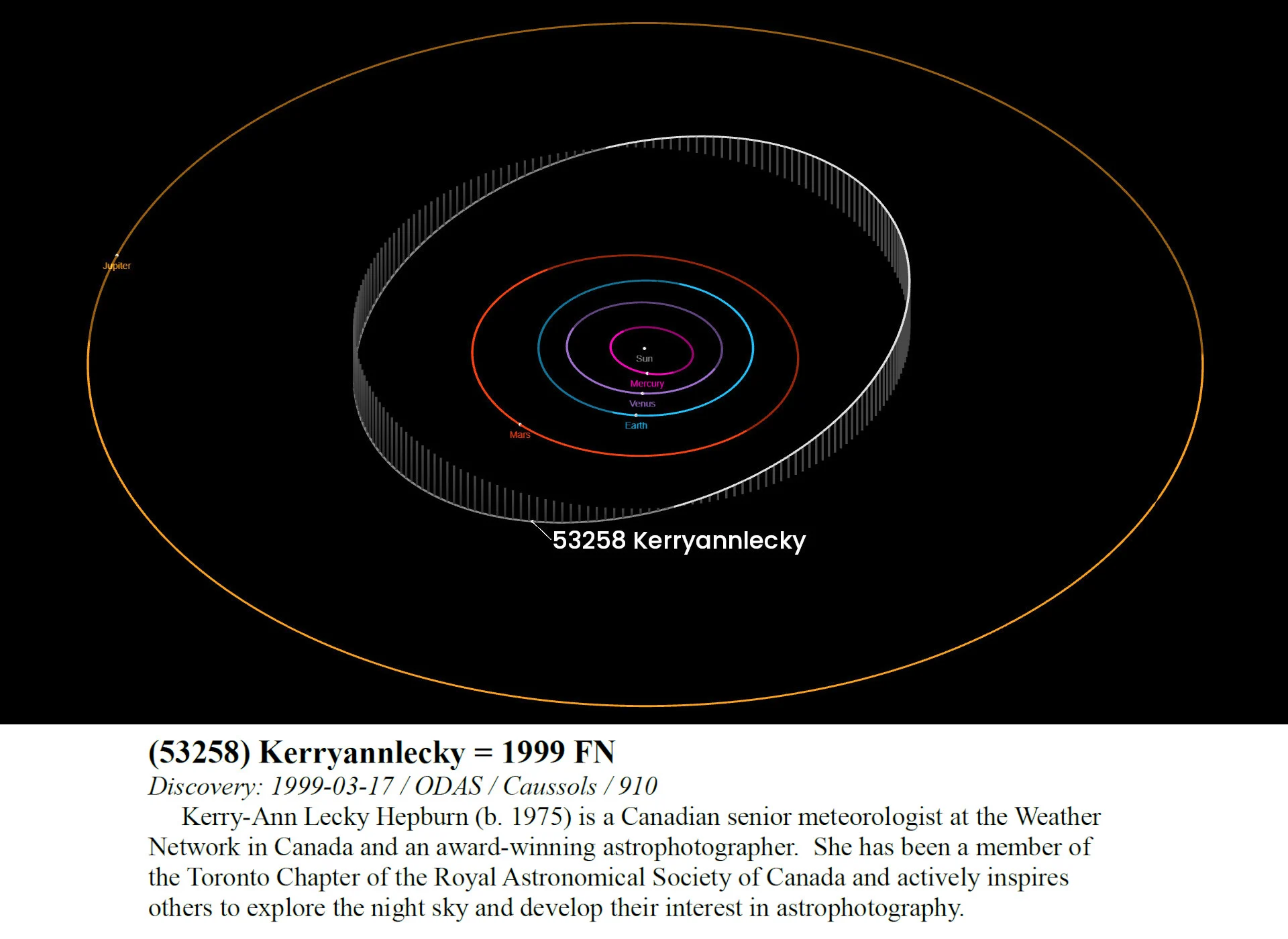
The orbit of asteroid 1999 FN, now newly named (53258) Kerryannlecky, as shown in NASA JPL's asteroid database, along with the entry in the International Astronomical Union's WGSBN Bulletin, Volume 5, #2, dated Feb. 3, 2025, detailing the asteroid's renaming. (NASA/JPL-Caltech, IAU)
Kerry-Ann Lecky Hepburn has been a part of The Weather Network's forecasting team for over two decades. She is also well known, internationally, for her award-winning astrophotography.
"I stumbled on Kerry-Ann's work years ago when she posted some of her images on social media, and immediately recognized her talent," says astronomer Phil Plait, aka The Bad Astronomer. "Astrophotography involves a tremendous technical skill, but to really excel it also takes a keen eye and sense of artistry. She possesses all these, and it really shows in her work."
We sat down with Kerry-Ann to ask her about this amazing honour, her experiences with photographing the night sky, and what she recommends for those interested in pursuing astrophotography.
(Editor's note: Kerry-Ann's answers have been edited for length and clarity.)
The Weather Network: So, how did you get an asteroid named after you?
Kerry-Ann Lecky Hepburn: Being in the astronomy and astrophotography community for many years, I've come across and collaborated with some incredible and talented people. Two of those people are Yuri Beletsky, a famous astrophotographer, and Alain Maury who runs a lodge in Chile's Atacama Desert catering to those who want to photograph and explore the night sky. Alain has also discovered and co-discovered many asteroids. So, Yuri and Alain were gracious enough to nominate my name to be on one of the asteroids he discovered. This was a wonderful surprise to me.
TWN: How do you feel about essentially being immortalized in the solar system?
Kerry-Ann: Many people have asked me that, and honestly, as a Christian, the first thought that popped into my head was that God has already named all the stars. But I will say, I'm humbled and so thankful to my friends for nominating me.
Plus, it will be the coolest thing to be able to just type my name into a planetarium app and see this asteroid pop up!
TWN: What do we know about (53258) Kerryannlecky?
Kerry-Ann: It is approximately 4.3 kilometres in diameter, and its orbit lies entirely within the asteroid belt between Mars and Jupiter.

The orbit of 53258 Kerryannlecky, between the orbits of Mars and Jupiter, as simulated by the open source astronomy program, Celestia. (Celestia/Scott Sutherland)
So, thankfully, it poses no threat to Earth.
For anyone who wants to observe or photograph it with a telescope, it is currently in the constellation Sextans, and is very faint at magnitude 17.
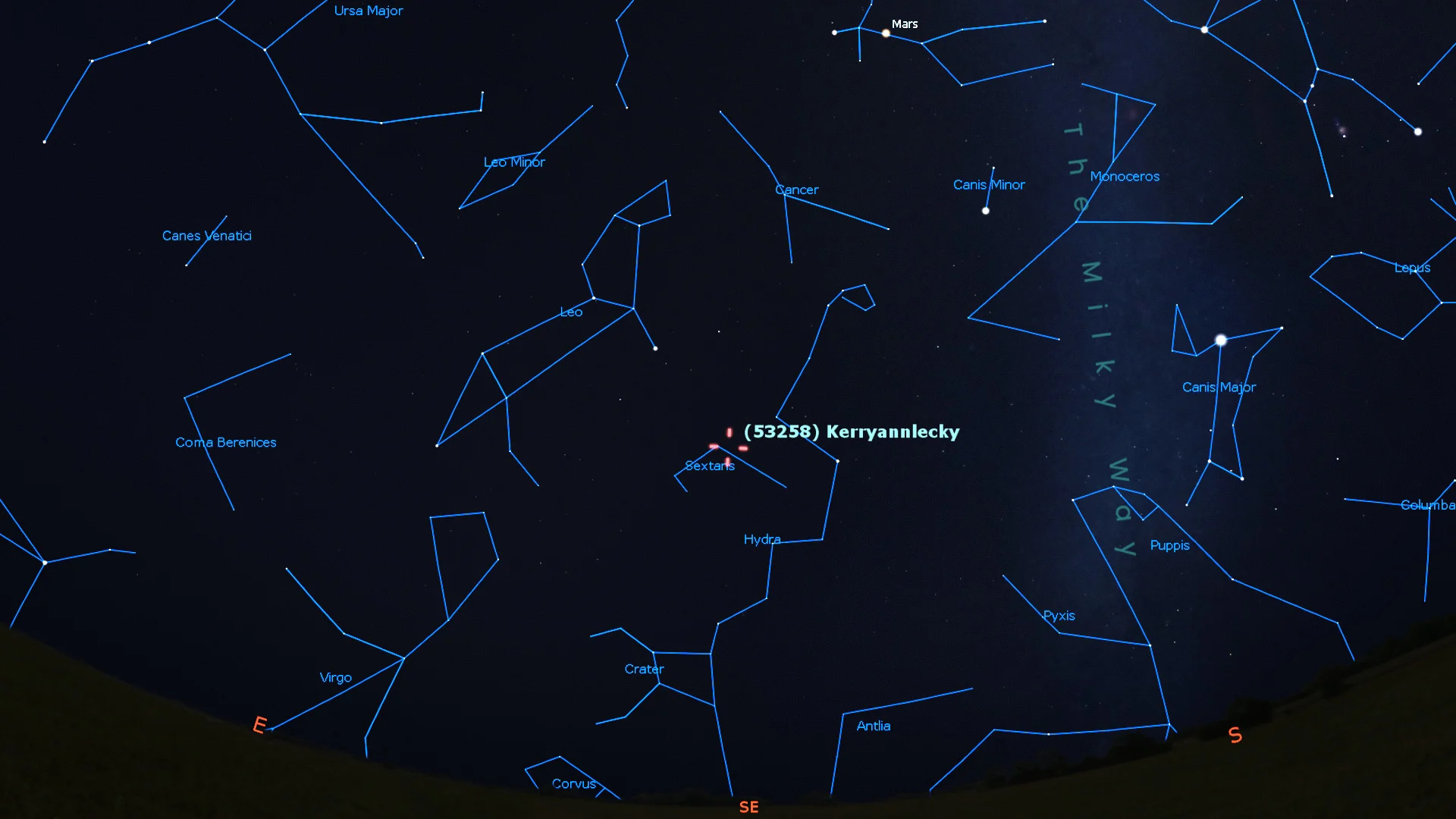
53258 Kerryannlecky's current location, as of late March, among the night sky's constellations. (Stellarium/Scott Sutherland)
(Author's note: magnitude in astronomy refers to how bright an object is in the sky. The smaller the number, the brighter the object, with the brightest objects having negative magnitude — The Sun at -26.83, Full Moon at −12.60, Venus at -4.2, Jupiter at -2.2, and Sirius at -1.5, are some good examples. Any object with a magnitude of 7 or above requires at least a pair of binoculars to see, while anything with a magnitude over 9.5 requires a telescope. To see and capture an image of 53258 Kerryannlecky, you would need a telescope with an aperture of at least 600-700 mm, and taking an image exposure of around 30 seconds, similar to how the Catalina Sky Survey and the Asteroid Terrestrial-impact Last Alert System (ATLAS) spot asteroids.)
TWN: How did you get your start in astrophotography?
Kerry-Ann: Ever since I was about 10 years old, I’ve been fascinated by the solar system and deep space. My parents were great supporters of my interest, buying me books, a telescope, and subscriptions to magazines such as Astronomy and Sky & Telescope.
In high school, I took a film photography course and started thinking about the possibility of attaching my camera to the telescope. Without the internet, back then, I had no idea what I was doing at first. I just experimented with exposures, wasting a lot of film in the process, but eventually, I managed to capture some grainy images of Jupiter, Venus, and the Moon. The quality didn’t matter, though, I was completely hooked after just seeing some recognizable pictures.
Since then, I’ve been honing my skills in astrophotography and loving every moment of the journey.
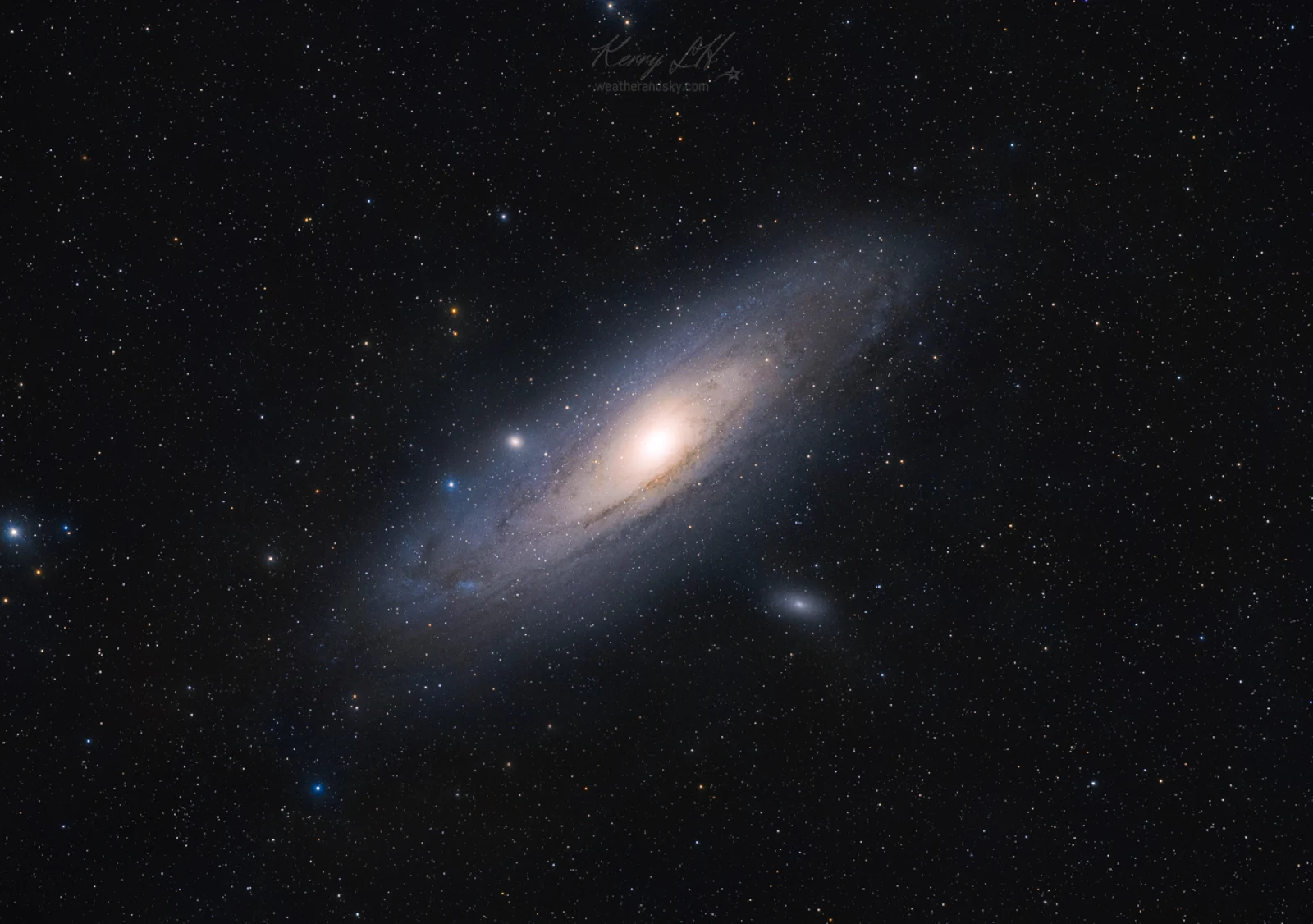
M31, also known as the Andromeda Galaxy, compiled from 54 separate 1-minute exposures, taken on October 6, 2024. The brightest "star" above Andromeda's core is the satellite galaxy, Messier 32, while another satellite galaxy, Messier 110, shines to the lower right of Andromeda's core. (Kerry-Ann Lecky Hepburn, used with permission)
TWN: Do you have a favourite astrophotography target?
Kerry-Ann: My favourite targets are dark, dusty nebulae that reflect the colours of nearby stars, also known as reflection nebulae.
One particularly beautiful target is the Rho Ophiuchi region.
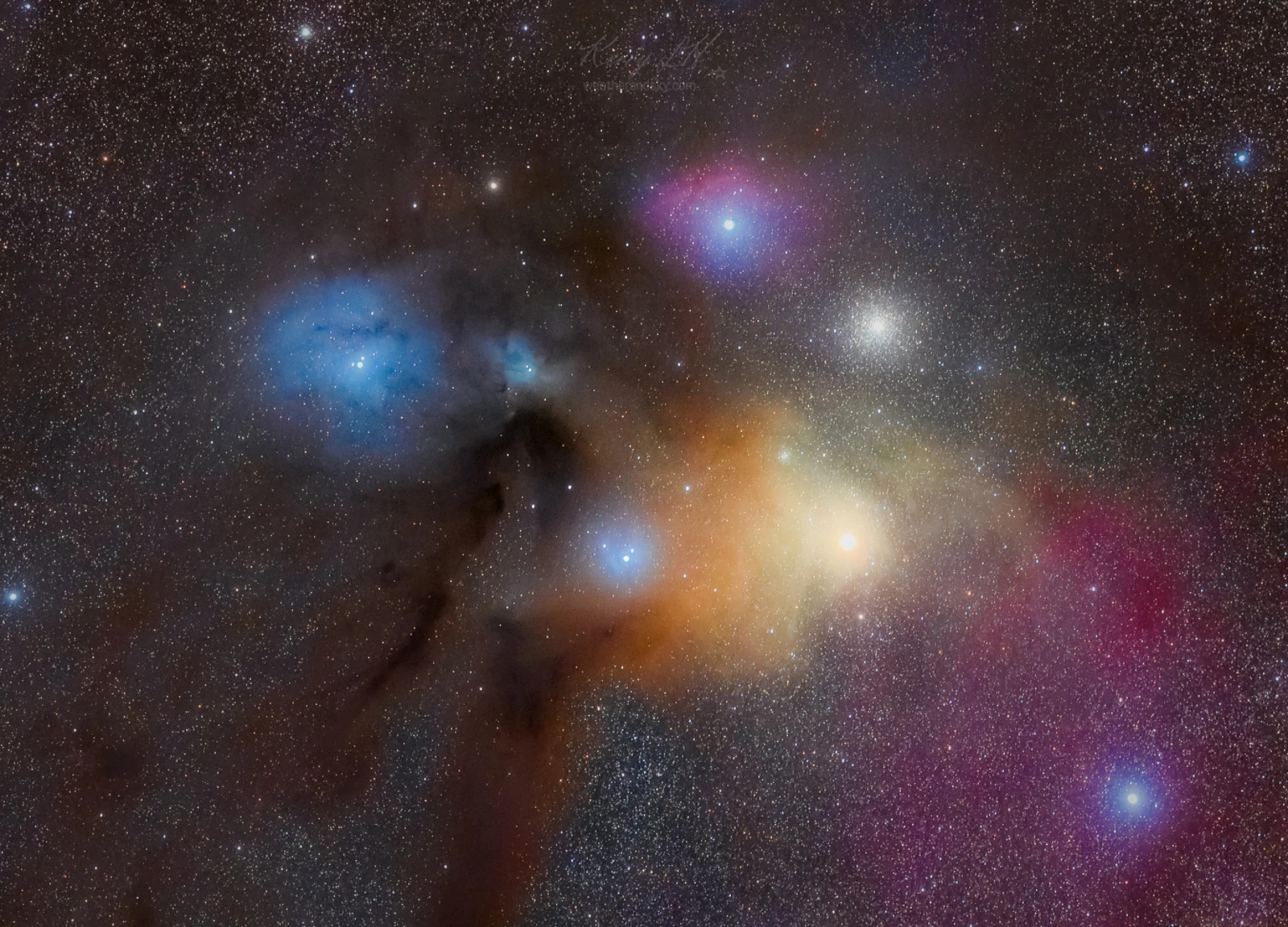
A section of Rho Ophiuchi, as imaged in 2022 from the Atacama Desert in Chile. This region shows a beautiful combination of colours formed by star light reflecting off of the dust and hydrogen gas which is reddish pink. (Kerry-Ann Lecky Hepburn, used with permission)
This object was one that I dreamed of imaging since I started astrophotography because it has so many colours from the stars reflecting on the dusty clouds, along with large areas of hydrogen gas.
TWN: What advice do you have for someone who is interested in starting astrophotography?
Kerry-Ann: Anyone with a camera or even a smartphone can start capturing the night sky.
First, download a planetarium app, to help you learn the locations of objects in the night sky. (Author's note: Stellarium is an excellent example.) Using the app, start by identifying constellations, as they are a great foundation for navigating the cosmos.
Next, start by taking pictures of these constellations and even the Milky Way. Find a dark location away from city lights and experiment with capturing long exposures while keeping your camera stable on a solid surface or tripod.
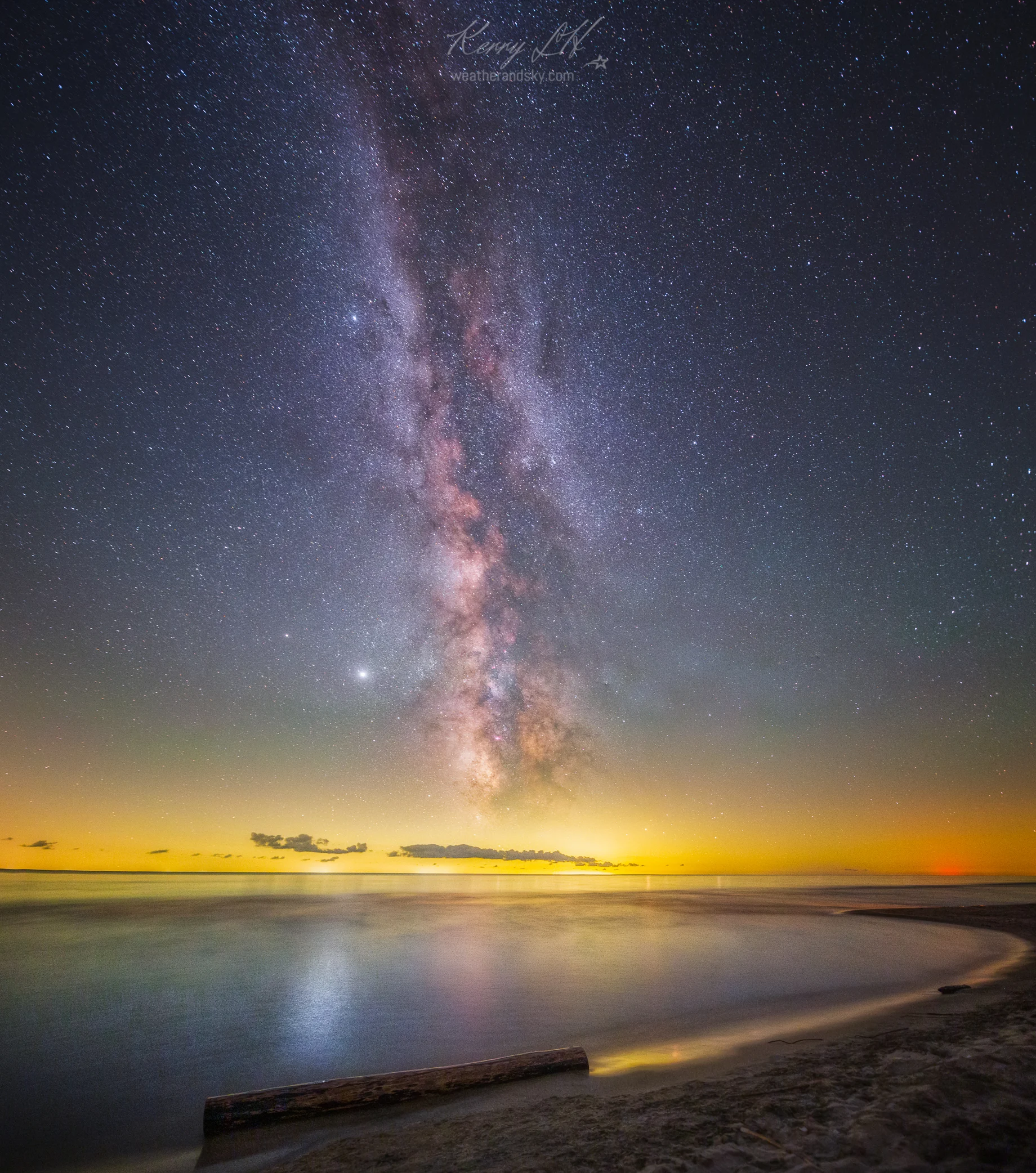
The Milky Way extends from horizon to zenith in this beautiful panoramic shot from Long Point, along the northern shore of Lake Erie, taken in 2020. (Kerry-Ann Lecky Hepburn, used with permission)
Once you become more advanced, the next step is to invest in a star tracker. Star trackers allow your camera to move with the night sky’s motion, enabling you to take even longer exposures while zooming in on specific celestial targets.
There are plenty of online resources for learning astrophotography, and YouTube is a great place to start. If you prefer hands-on learning, I suggest joining a local astronomy club (like one of the chapters in the Royal Astronomical Society of Canada or an independent club) where you will meet many people who have similar interests. Also, joining astrophotography workshops or photo tours will get you started even quicker.
To see more of Kerry-Ann's spectacular astrophotography, visit her Instagram page, at www.instagram.com/weatherandsky.
DON'T MISS: Get to know the hidden gems across Canada
How are asteroids named?
When an asteroid is discovered out in space, getting its final name can take years. Asteroid Kerryannlecky, for example, was first spotted on March 17, 1999, but didn't get its name until nearly 26 years later!
The first 'name' an asteroid goes by is a temporary one, while astronomers confirm that it is a new object that has never been observed before.
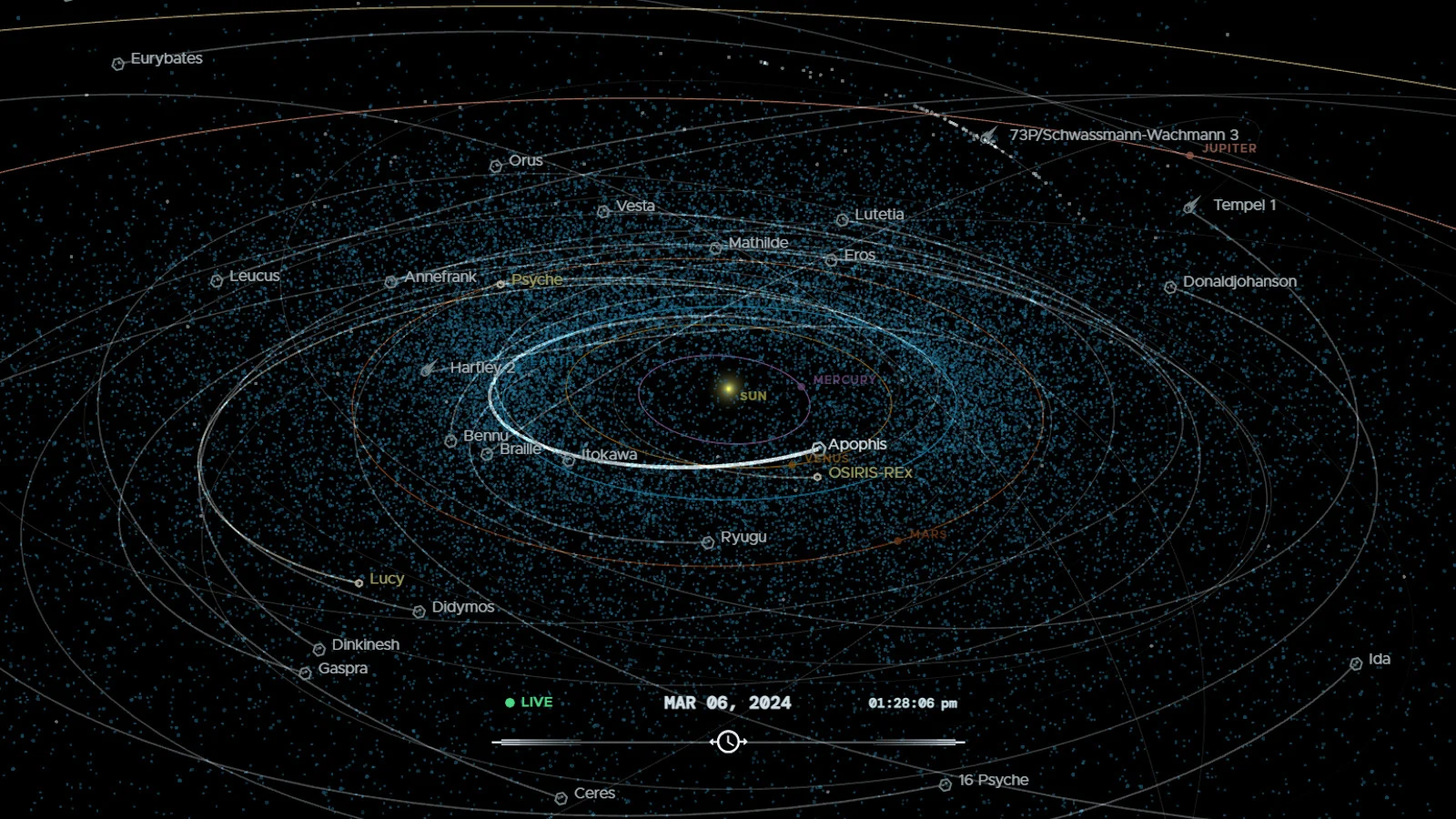
A view of the inner solar system showing thousands of asteroids catalogued by NASA's Eyes on Asteroids. (NASA)
Once that confirmation has been made, the object is given a 'provisional designation' that represents the timing of its discovery, for example, 1999 FN.
The first four numbers of the provisional designation are the year of the asteroid's discovery. Following the year, the first letter denotes the half-month of its discovery: A for January 1-15, B for January 16-31, C for February 1-15, etc. The letters I and Z left out, since there are only 24 half-months. The second letter, along with any numbers that might follow it, tell us what order the asteroid was discovered in that half-month. The first 25 asteroids found in that half-month simply get a second letter added (A through Z, leaving out I). When the 26th to 50th are discovered, the letters start over again, but with the number 1 after (or as a subscript next to it). The 51st to 75th asteroids are A2 through Z2, 76th to 100th are A3 through Z3, and this continues until you either run out of asteroids or transition into the next half-month.
Thus, just from the name 1999 FN we can tell it is the 13th asteroid discovered in the latter half of March in 1999.

How to read an asteroid's provisional designation. (Wikipedia/Scott Sutherland)
A more extreme example, asteroid 2007 TA418, was the 10,451st asteroid found in the first half of October 2007. Its subscript is so high due to numerous dedicated asteroid detection programs coming online, such as the Sloan Digital Sky Survey and the Catalina Sky Survey, which were finding hundreds or thousands of objects every night.
Once an object has been observed enough times to lock down its orbit, it is officially recognized with a catalogue number. 1999 FN's catalogue number is 53258, making it the 53,258th asteroid to be so recognized. The person who discovered it has 10 years from when it received its official number to suggest a name. After that, the privilege opens up to anyone else who contributed significantly to its discovery or orbit classification, or who is associated with the telescope or observatory that found it.
To become official, all asteroid names first go through the International Astronomical Union's Working Group Small-Body Nomenclature (WGSBN). This team of IAU members evaluates each name based on whether it meets all the requirements for length and content.
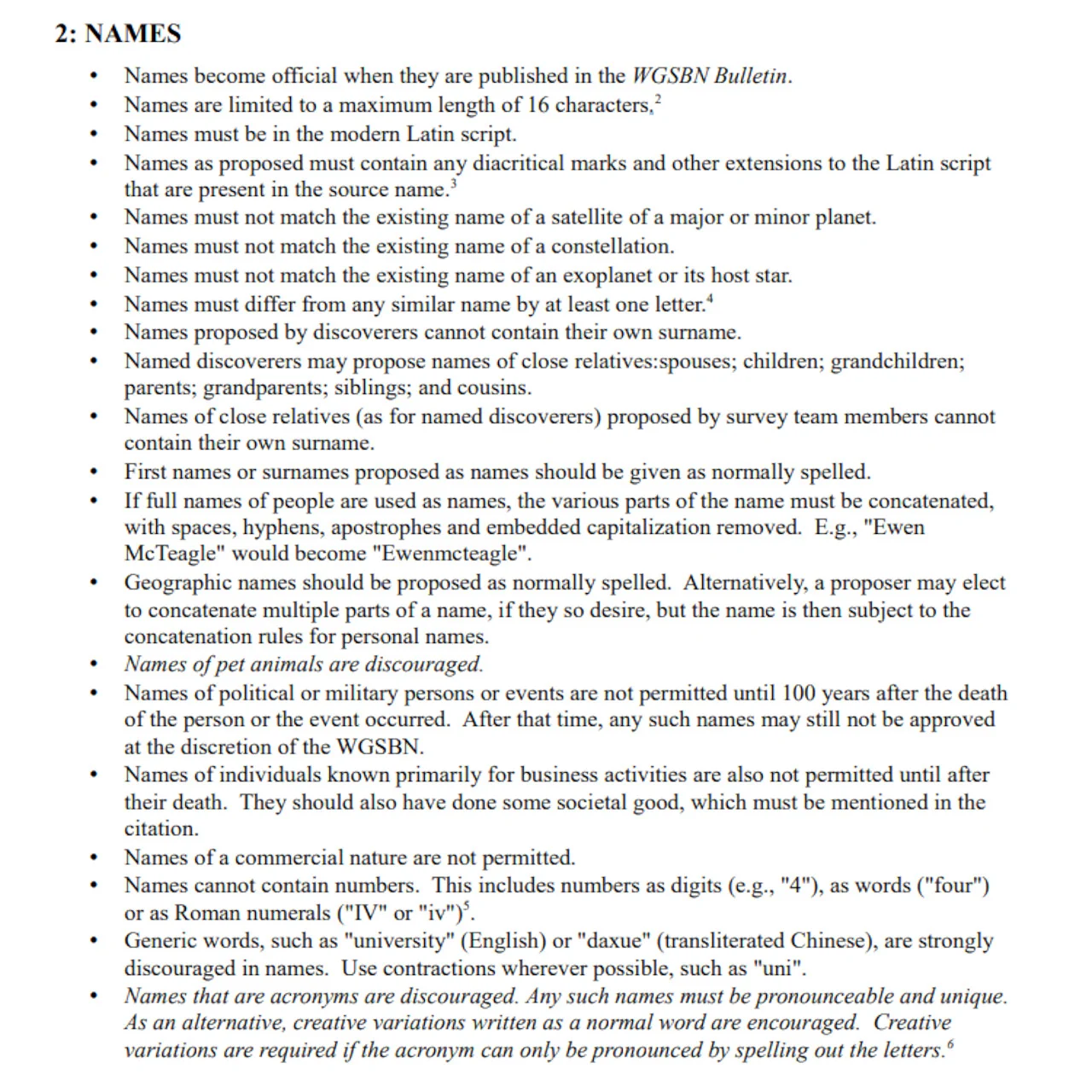
The detailed rules the WGSBN uses for asteroids are listed here, covering how long the name should be, how it should be spelled, and who or what an asteroid can be named after. (IAU)
Names submitted are voted upon, and those receiving an overwhelming majority from the 11 voting members of the group pass.
Only then, after this exhaustive process of discovery, observation, and scrutiny, is the name finally published in the next WGSBN Bulletin, and officially written among the stars.
So, to anyone who wants to someday name an asteroid, the advice from the IAU's Minor Planet Center is "Go out and discover one!"
(Thumbnail image courtesy Kerry-Ann Lecky Hepburn, with a small reticule added by the author to represent the asteroid newly named for her)
